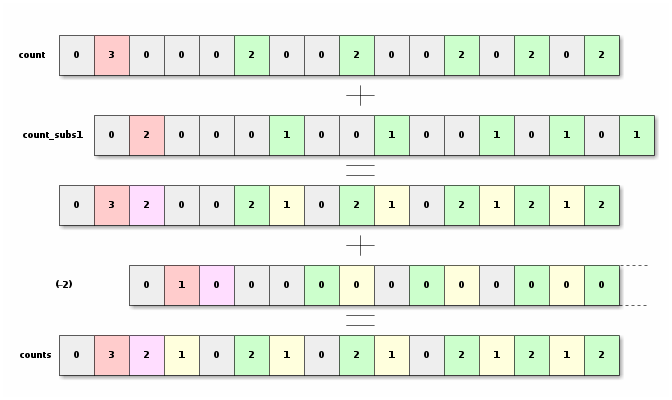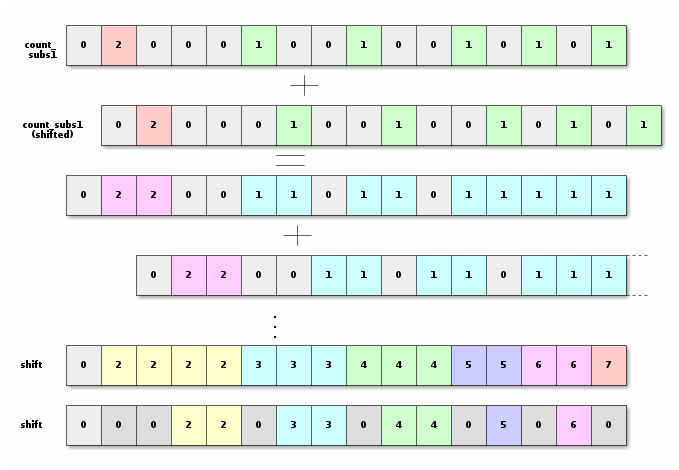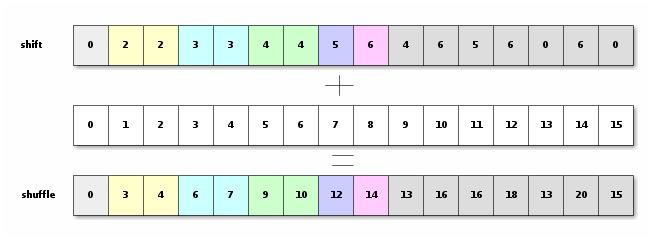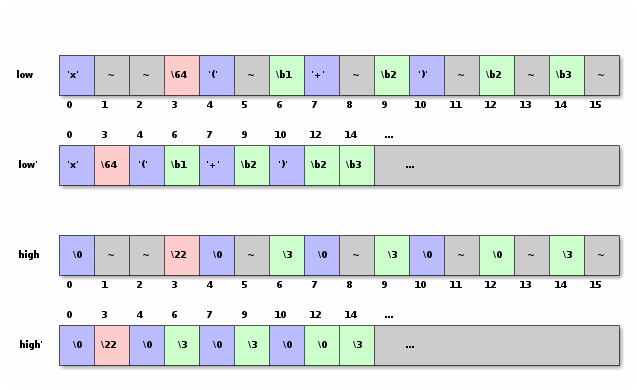UTF-8 processing using SIMD (SSE4)
SIMD: "Single instruction, multiple data" is a class of instructions present in many CPUs today. For example, on the Intel CPU they are known under the SSE acronym. Those instructions enable more parallelism by operating simultaneously on multiple data.
In this blog post I will present a method for converting UTF-8 text to UTF-16 using SSE4 compiler intrinsics. My goal is also to introduce you to the SIMD intrinsics, if you are not familiar with them yet.
About Intrinsics
CPUs can parallelize computations by using specials instructions that operate simultaneously
on multiples values.
There are large registers that contain vectors of values.
For example, the SSE registers are 128 bits vectors
that can contain either 2 double, 4 float, 4 int, 8 short or up to 16 char values.
Then, one single instruction can add, substract, multiply, ... all those values and put the
result in another vector register.
This is called SIMD for Single Instruction Multiple Data.
Compilers can sometimes automatically vectorize the contents of a simple loop, but they are not really good at it. If the loop is too complex or if it depends on the previous iteration, the compiler will fail to vectorize. (Even if it would be obvious for an human). The vectorization therefore has to be done manually.
This is where compiler intrinsics help us. They are special functions handled directly in the compiler who will emit the instruction we want.
The problem with intrinsics is that they are not really portable. They target a specific architecture. This means you need to write your algorithms for the different CPU architectures you target. Fortunately, the main compilers use the same intrinsics so they are portable across compilers and operating systems.
You are supposed to detect the support of the instruction set at run-time. What is usually done is to write several variants of the function for the different target architecture and have a function pointer that is set to the best variant for the running architecture.
The best documentation I could find is the reference on MSDN. You will have to browse it a bit to see what the available intrinsics are.
The Task: Converting UTF-8 to UTF-16
I got interested in SIMD when Benjamin was using them to speed up
QString::fromLatin1,
which converts a char* encoded in
Latin-1 to
UTF-16 (QString's internal encoding).
After he explained to me how it works, I was able to speed up some of the drawing code inside Qt.
However in Qt5, we
changed the default string encoding from Latin-1 to UTF-8.
UTF-8 can represent all of Unicode while Latin-1 can only represent the alphabet of a few latin based languages. UTF-8 parsing is much more difficult to vectorize because a single code point can be encoded by a variable number of bytes.
This table explains the correspondence between the bits in UTF-8 and UTF-16:
| UTF-8 | UTF-16 | |
|---|---|---|
| ASCII (1 byte) | 0aaaaaaa |
00000000 0aaaaaaa |
| Basic Multilingual Plane (2 or 3 bytes) |
110bbbbb
10aaaaaa |
00000bbb
bbaaaaaa |
1110cccc
10bbbbbb
10aaaaaa |
ccccbbbb
bbaaaaaa |
|
| Supplementary Planes (4 bytes) |
11110ddd
10ddcccc
10bbbbbb
10aaaaaa uuuu = ddddd - 1 |
110110uu uuccccbb |
I was wondering if we could improve QString::fromUtf8 using SIMD.
Most of the strings are just ASCII which is easy to vectorize,
but I wanted to also try to go ahead and vectorize the more complicated cases as well.
However, the 4 bytes sequences (Supplementary Planes) are very rarely used
(most used languages and useful symbols are already in the Basic Multilingual Plane)
and also more complicated so I did not vectorize that case for
the scope of this blog post.
This is left as an exercise for the reader ;-)
Previous work
UTF-8 processing is a very common task. I was expecting that the problem would be already solved. Currently however most libraries and applications still have a scalar implementation. Few use vectorization, but only for ASCII.
There is a library called u8u16.
It uses a clever technique by separating the bits in individual vectors.
It is processing 128 char at the time in 8 different vectors.
I wanted to try a different approach and work directly on one vector.
Working with 16 char at the time allows speeding up the processing of
smaller strings.
The Easy Case: ASCII
I'm going to start by explaining the simple case when we only
have ASCII. This is very easy to vectorize because for ASCII one byte in UTF-8
is always one byte in UTF-16 with \0 bytes in between.
ASCII is also a very common encoding so it make sense to have a special case for it.
I will start by showing the code and then explaining it
Our function takes a pointer src to the UTF-8 buffer of length len,
and a pointer dst to a buffer of size at least len*2
where we will store the UTF-16 output. The function returns the size of the UTF-16 output.
int fromUtf8(const char *src, int len, unsigned short *dst) {
/* We will process the input 16 bytes at a time,
so the length must be at least 16. */
while(len >= 16) {
/* Load 128 bit into a vector register. We use the 'loadu' intrinsic
where 'u' stands for unaligned. Loading aligned data is much faster,
but here we don't know if the source is aligned */
__m128i chunk = _mm_loadu_si128(reinterpret_cast<const __m128i*>(src));
/* Detect if it is ASCII by looking if one byte has the high bit set. */
if (!_mm_movemask_epi8(chunk)) {
// unpack the first 8 bytes, padding with zeros
__m128i firstHalf = _mm_unpacklo_epi8(chunk, _mm_set1_epi8(0));
// and store to the destination
_mm_storeu_si128(reinterpret_cast<__m128i*>(dst), firstHalf);
// do the same with the last 8 bytes
__m128i secondHalf = _mm_unpackhi_epi8 (chunk, _mm_set1_epi8(0));
_mm_storeu_si128(reinterpret_cast<__m128i*>(dst+8), secondHalf);
// Advance
dst += 16;
src += 16;
len -= 16;
continue;
}
// handle the more complicated case when the chunk contains multi-bytes
// ...
}
// handle the few remaining bytes using a classical serial algorith
// ...
}
The type __m128i represents a vector of 128 bits.
It is most likely going to be stored in a SSE register.
Since we don't know the alignment, we load the data with
_mm_loadu_si128.
There is also the
_mm_load_si128
that assumes the memory
is aligned on 16 bytes. Because it is faster to operate on aligned data, some algorithms
sometimes start with a prologue to handle the first bytes until the rest is aligned.
I did not do that here but we could optimize the ASCII processing further by doing so.
Once we have loaded 16 bytes of data into chunk, we need to check if
it only contains ASCII. Each ASCII byte should have its most significant bit set to 0.
_mm_movemask_epi8
creates a 16bit mask out of most significant bits of our 16 bytes in the vector.
If that mask is 0 we only have ASCII in that vector.
The next operation is to expand with zeroes. We will do what is called unpacking.
The instructions
_mm_unpackhi_epi8
and _mm_unpacklo_epi8
are going to interleave two vectors.
Because the result of an unpack is on 32 bytes, there is two operations:
one to get the first 16 high bytes,
and the other to get the low bytes.
_mm_set1_epi8(0) creates a vector filled with zeroes.

Note that vectors are in little endian, so I show the least significant bytes first
Now, we can just store the result with
_mm_storeu_si128.
We use the unaligned operation again.
General Algorithm
Now that I have introduced you to the ASCII decoding process, we can move on to the general case, in which we might have multiple bytes for one character.
The algorithm proceeds with the following steps:
- First, we will classify each bytes so we know where the values in the sequence are and how long they are. This information will be stored in vectors that we can use to mask so operations we do later operate only on a certain category of bytes.
- Then, we will operate on the data to to find the actual Unicode value behind each character. They will be stored at the location of the last byte of a sequence, into two different vectors: one for the low bits and one for the high bits.
- Then we need to shuffle the vectors to remove the possible "gaps" left by multi-bytes sequences.
- Finally, we can store the result and advance the pointers.
I will explain every step in more detail.
In our example, I will decode the string
x≤(α+β)²γ²,
which is represented in UTF-8 as
x\e2\89\a4(\ce\b1+\ce\b2)\c2\b2\ce\b3\c2\b2.
The "≤" is represented by 3 bytes, the Greek letters by two bytes,
and the "²" also by two bytes. The total length is 17 bytes, so the last byte
will be truncated when loaded into the vector
Classification
At the end of this step, we will have the following vectors:
masktells which bit needs to be set to 0 in order to only keep the bits that are going to end up in the Unicode value. Bits of mask that are set will be unset from the data.countis zero if the corresponding byte is ASCII or a continuation byte. If the corresponding byte is starting a sequence, then it is the number of bytes in that sequence.countsrepresents (for each byte) how many bytes are remaining in this sequence. It is 0 for ASCII, 1 for the last byte in a sequence, and so on.
We start by finding count and mask.
I do that by computing a vector
that I called state, in which the 5 higher bits are the mask and the
3 lower bits represent the count.

We will use the
_mm_cmplt_epi8 instruction.
It compares two vectors of 16 signed char,
and returns a mask vector where each byte is equal to 0xff
or 0x00 depending of the result of the comparison between
the corresponding chars.
We can then use this mask as input to the
_mm_blendv_epi8
SSE4 instruction.
It takes 3 input arguments: two vectors and a mask. It returns a vector that has
the bytes of the second input where the most significant bit of the corresponding byte of the mask is one
and the bytes of the first input otherwise.
In other words, for each 16 bytes of the vectors, we have:
output[i] = mask[i] & 0x80 ? input2[i] : input1[i]
The problem of _mm_cmplt_epi8 is that it only works on signed bytes.
That is why we add 0x80 to everything simulate unsigned comparison.
// The state for ascii or contiuation bit: mask the most significant bit.
__m128i state = _mm_set1_epi8(0x0 | 0x80);
// Add an offset of 0x80 to work around the fact that we don't have
// unsigned comparison
__m128i chunk_signed = _mm_add_epi8(chunk, _mm_set1_epi8(0x80));
// If the bytes are greater or equal than 0xc0, we have the start of a
// multi-bytes sequence of at least 2.
// We use 0xc2 for error detection, see later.
__m128i cond2 = _mm_cmplt_epi8( _mm_set1_epi8(0xc2-1 -0x80), chunk_signed);
state = _mm_blendv_epi8(state , _mm_set1_epi8(0x2 | 0xc0), cond2);
__m128i cond3 = _mm_cmplt_epi8( _mm_set1_epi8(0xe0-1 -0x80), chunk_signed);
// We could optimize the case when there is no sequence logner than 2 bytes.
// But i did not do it in this version.
//if (!_mm_movemask_epi8(cond3)) { /* process max 2 bytes sequences */ }
state = _mm_blendv_epi8(state , _mm_set1_epi8(0x3 | 0xe0), cond3);
__m128i mask3 = _mm_slli_si128(cond3, 1);
// In this version I do not handle sequences of 4 bytes. So if there is one
// we break and do a classic processing byte per byte.
__m128i cond4 = _mm_cmplt_epi8(_mm_set1_epi8(0xf0-1 -0x80), chunk_signed);
if (_mm_movemask_epi8(cond4)) { break; }
// separate the count and mask from the state vector
__m128i count = _mm_and_si128(state, _mm_set1_epi8(0x7));
__m128i mask = _mm_and_si128(state, _mm_set1_epi8(0xf8));
From count I will be able to compute counts.
I will use _mm_subs_epu8 which substracts
two vector of unsigned bytes and saturate (so if you underflow, it sets 0).
Then I shift that result, and add it to the count.
Then we do the same, but we substract 2 and shift the result two bytes.
_mm_slli_si128 shifts a vector on the left by the given number of bytes.
Notice again that we work on little endian.
So that is why I shifted right on the picture, but left in the code.

//substract 1, shift 1 byte and add
__m128i count_subs1 = _mm_subs_epu8(count, _mm_set1_epi8(0x1));
__m128i counts = _mm_add_epi8(count, _mm_slli_si128(count_subs1, 1));
//substract 2, shift 2 bytes and add
counts = _mm_add_epi8(counts, _mm_slli_si128(
_mm_subs_epu8(counts, _mm_set1_epi8(0x2)), 2));
Processing
The goal of this step is to end up with the final unicode bytes values. They will be split into two vectors (one for the high bytes and one for the low bytes). We keep them in the location of the last byte of a sequence, which means that there will be "gaps" in the vector.

There is no instructions that shift the whole vector by an arbitrary
number of bits. It is only possible to shift by an integer number of bytes with
_mm_slli_si128 or _mm_srli_si128.
The instructions that shift by an abitrary number of bits only work on vector
with elements of 16 or 32 bits. No 8 bits elements.
We will use what we have and will first shift by one byte (in
chunk_right) and then shift and mask to get what we want.
// Mask away our control bits with ~mask (and not)
chunk = _mm_andnot_si128(mask , chunk);
// from now on, we only have usefull bits
// shift by one byte on the left
__m128i chunk_right = _mm_slli_si128(chunk, 1);
// If counts == 1, compute the low byte using 2 bits from chunk_right
__m128i chunk_low = _mm_blendv_epi8(chunk,
_mm_or_si128(chunk, _mm_and_si128(
_mm_slli_epi16(chunk_right, 6), _mm_set1_epi8(0xc0))),
_mm_cmpeq_epi8(counts, _mm_set1_epi8(1)) );
// in chunk_high, only keep the bits if counts == 2
__m128i chunk_high = _mm_and_si128(chunk ,
_mm_cmpeq_epi8(counts, _mm_set1_epi8(2)));
// and shift that by 2 bits on the right.
// (no unwanted bits are comming because of the previous mask)
chunk_high = _mm_srli_epi32(chunk_high, 2);
// Add the bits from the bytes for which counts == 3
__m128i mask3 = _mm_slli_si128(cond3, 1); //re-use cond3 (shifted)
chunk_high = _mm_or_si128(chunk_high, _mm_and_si128(
_mm_and_si128(_mm_slli_epi32(chunk_right, 4), _mm_set1_epi8(0xf0)),
mask3));
Shuffle
Now, we need to get rid of the gaps in our strings.
We will start by computing, for each byte, the number of bytes we need to shift.
We notice that count_subs1is the number of bytes we need to skip
for a given sequence.
We will then accumulate all those number in order to get the number of bytes
we need to shift each bytes. Then we reset to zero all the bytes that are supposed
to go away.

__m128i shifts = count_subs1;
shifts = _mm_add_epi8(shifts, _mm_slli_si128(shifts, 2));
shifts = _mm_add_epi8(shifts, _mm_slli_si128(shifts, 4));
shifts = _mm_add_epi8(shifts, _mm_slli_si128(shifts, 8));
// keep only if the corresponding byte should stay
// that is, if counts is 1 or 0 (so < 2)
shifts = _mm_and_si128 (shifts , _mm_cmplt_epi8(counts, _mm_set1_epi8(2)));
We will shift the shift vector so the meaning of it becomes
the number of bytes that are separating a byte in its final location from
the byte in its original location.
The maximum we can shift is 10 (if everything is a 3 bytes sequence).
We can then compute in 4 steps.
We will shift the interesting bit of the vector shift, so it can be used
to control the blend operation.
shifts = _mm_blendv_epi8(shifts, _mm_srli_si128(shifts, 1),
_mm_srli_si128(_mm_slli_epi16(shifts, 7) , 1));
shifts = _mm_blendv_epi8(shifts, _mm_srli_si128(shifts, 2),
_mm_srli_si128(_mm_slli_epi16(shifts, 6) , 2));
shifts = _mm_blendv_epi8(shifts, _mm_srli_si128(shifts, 4),
_mm_srli_si128(_mm_slli_epi16(shifts, 5) , 4));
shifts = _mm_blendv_epi8(shifts, _mm_srli_si128(shifts, 8),
_mm_srli_si128(_mm_slli_epi16(shifts, 4) , 8));

Then we can then know, for each byte in the final vector, its
location in the original vector. With that information, we can use
_mm_shuffle_epi8
(SSSE3) to shuffle the vector and remove the
"gaps". Then we can unpack the result and store it, and we are almost done.


__m128i shuf = _mm_add_epi8(shifts,
_mm_set_epi8(15,14,13,12,11,10,9,8,7,6,5,4,3,2,1,0));
// Remove the gaps by shuffling
shuffled_low = _mm_shuffle_epi8(chunk_low, shuf);
shuffled_high = _mm_shuffle_epi8(chunk_high, shuf);
// Now we can unpack and store
__m128i utf16_low = _mm_unpacklo_epi8(shuffled_low, shuffled_high);
__m128i utf16_high = _mm_unpackhi_epi8(shuffled_low, shuffled_high);
_mm_storeu_si128(reinterpret_cast<__m128i*>(dst), utf16_low);
_mm_storeu_si128(reinterpret_cast<__m128i*>(dst+8) , utf16_high);
Error Detection
So far we have only considered valid UTF-8. But a conform UTF-8 decoder should also handle broken UTF-8. It should detect the following error cases:
- Not enough, misplaced or too many continuation characters.
- Overlong forms: If a sequence decodes to a value that could have been encoded in a shorter sequence.
For example the quote must be encoded in its ASCII form (
\22) and not in a multi-byte sequence (\c0\a2or\e0\80\a2). Not forbidding those forms could lead to security problems, e.g. if the the quote where escaped in the utf-8 input string, but appears again later when decoded. - Invalid or reserved Unicode code point (for example, the one reserved for UTF-16 surrogates)
Since error is not the common case, what I do in that case is to break, and let the rest be handled by the sequential algorithm (Just like when we have 4 bytes sequences).
// ASCII characters (and only them) should have the
// corresponding byte of counts equal 0.
if (asciiMask ^ _mm_movemask_epi8(_mm_cmpgt_epi8(counts, _mm_set1_epi8(0))))
break;
// The difference between a byte in counts and the next one should be negative,
// zero, or one. Any other value means there is not enough continuation bytes.
if (_mm_movemask_epi8(_mm_cmpgt_epi8(_mm_sub_epi8(_mm_slli_si128(counts, 1),
counts), _mm_set1_epi8(1))))
break;
// For the 3 bytes sequences we check the high byte to prevent
// the over long sequence (0x00-0x07) or the UTF-16 surrogate (0xd8-0xdf)
__m128i high_bits = _mm_and_si128(chunk_high, _mm_set1_epi8(0xf8));
if (!_mm_testz_si128(mask3,
_mm_or_si128(_mm_cmpeq_epi8(high_bits,_mm_set1_epi8(0x00)) ,
_mm_cmpeq_epi8(high_bits,_mm_set1_epi8(0xd8))) ))
break;
// Check for a few more invalid unicode using range comparison and _mm_cmpestrc
const int check_mode = _SIDD_UWORD_OPS | _SIDD_CMP_RANGES;
if (_mm_cmpestrc( _mm_cvtsi64_si128(0xfdeffdd0fffffffe), 4,
utf16_high, 8, check_mode) |
_mm_cmpestrc( _mm_cvtsi64_si128(0xfdeffdd0fffffffe), 4,
utf16_low, 8, check_mode))
break;
Advance Pointers
Now we are almost done. We just need to advance the source and destination pointers.
The source pointer usually advance by 16, unless it ends in the middle of a sequence.
In that case, we need to roll back 1 or 2 chars. For that, we look at the end of the
counts vector.
Then we can see how much we need to advance the destination by looking at the
end of the shift vector.

int s = _mm_extract_epi32(shifts, 3);
int dst_advance = source_advance - (0xff & (s >> 8*(3 - 16 + source_advance)));
int c = _mm_extract_epi16(counts, 7);
int source_advance = !(c & 0x0200) ? 16 : !(c & 0x02) ? 15 : 14;
dst += dst_advance;
src += source_advance;
Putting it all together
Now we are done, you can see the result there
I mixed all the operations to limit the dependencies between the operations that are next to each other to achieve better pipeline performance. I am surprised that the compiler did not do that for me.
Benchmarks Results
| Long Chinese text (8KiB) | 36 bytes of chinese text | Long ASCII (24KiB) | 20 ASCII bytes | |
|---|---|---|---|---|
| Iconv | 62000ns | 380ns | 165000ns | 230ns |
| Qt (scalar) | 43000ns | 180ns | 55000ns | 67ns |
| u8u16 | 20000ns | 300ns | 8000ns | 37ns |
| This solution (SSE4.1) | 22000ns | 110ns | 15000ns | 40ns |

We beat u8u16 on small strings but it is better on large strings because it processes more bytes at the same time. We are still better than any scalar processing.
I added some debug output in the implementation of QString::fromUtf8
in Qt 4.8 and ran few KDE applications translated in French.
The average size of strings that goes through this function is 9 characters.
More than 50% of the string are less than 2 character long, 85% are less than 16,
and 13% are between 16 and 128 characters long.
98% of the strings where only composed of ASCII. The rest was mainly having
2 bytes sequences and very few 3 bytes sequences. There is no sequence of 4 bytes.
Also consider that the processing of UTF-8 is probably far from being the bottleneck
of any application that does something useful.
So was my exercise useless? Maybe in practice, but I think there is still something to learn from this that can be applied to another algorithm that might be a bottleneck.
Woboq is a software company that specializes in development and consulting around Qt and C++. Hire us!
If you like this blog and want to read similar articles, consider subscribing via our RSS feed (Via Google Feedburner, Privacy Policy), by e-mail (Via Google Feedburner, Privacy Policy) or follow us on twitter or add us on G+.
Article posted by Olivier Goffart on 26 July 2012
Click to subscribe via RSS or e-mail on Google Feedburner. (external service).
Click for the privacy policy of Google Feedburner.
Google Analytics Tracking Opt-Out
Loading comments embeds an external widget from disqus.com.
Check disqus privacy policy for more information.